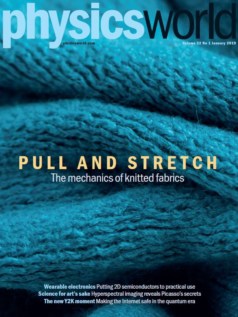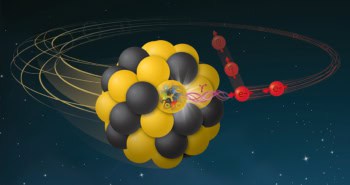
Happy new year to all Physics World readers!
I know you’re raring to go with 2019 so why not get up to speed by checking out the latest issue of Physics World magazine. We’ve got some treats for you, including a cover feature by freshly minted PhD physicist Samuel Poincloux, who’s been studying the physics of knitted fabrics.
There’s a great article by Nicola Towsend and Iddo Amit from Durham University about the challenges of using 2D semiconductors to create wearable electronic devices, while Stephen Ornes looks at the discoveries that the technique of “hyperspectral imaging” has made to artworks such as Pablo Picasso’s Mother and Child by the Sea.
Elsewhere in the issue, we’ve got the usual mix of news, opinion, reviews and careers, plus an intriguing Lateral Thoughts article by Sebastian Wood about the physics of turning water into wine.
You can enjoy the January 2019 issue of Physics World magazine via our digital apps for iOS, Android and Web browsers. (membership of the Institute of Physics required). Let us know what you think about the issue on Twitter, Facebook or by e-mailing us at pwld@iop.org.
For the record, here’s a run-down of what’s in the issue.
• The quantum space race – Siddarth Koduru Joshi from the University of Bristol tells Michael Banks why countries are racing to build the first quantum network in space
• It’s a quantum world – With a new era of quantum technology beckoning, James McKenzie examines the opportunities it offers for business and industry
• Revolting physics – Can the growth of solid-state physics be likened to a Star Wars plot? Robert P Crease agrees that it can
• The spirit of science – Liujun Zou says that China needs to do more to support fundamental science so that the country can play a leading part in the technologies of the future
• The future is flexible – Smartphones, tablets and laptops are stacked with computing power, but they’re mostly rigid, inflexible objects. Semiconductors that have been shrunk from 3D to 2D could, however, lead to flexible, wearable electronic devices, as Nicola Townsend and Iddo Amit explain
• Hidden pictures – Hidden beneath some masterpieces there are other paintings, visible only to state-of-the-art spectroscopic imaging techniques. Stephen Ornes looks at some of the secrets that hyperspectral imaging has uncovered.
• Knit and stretch – What do earthquakes, robotics and jumpers have in common? Samuel Poincloux explains why the answer lies with knitting – and how stretching a knitted material is rooted in mechanics.
• An anxious descent – Chanda Prescod-Weinstein reviews Anxiety and the Equation: Understanding Boltzmann’s Entropy by Eric Johnson.
• Hellions of the solar system – David Appell reviews Catching Stardust: Comets, Asteroids and the Birth of the Solar System by Natalie Starkey.
• Levelling the physics field – Female physicists who want to succeed in the workplace often face barriers that their male counterparts do not. Jennifer Dyer looks at how initiatives by the Institute of Physics, and other organizations, can help improve the careers of women in physics.
• Recipe for a miracle – Sebastian Wood wonders about the physics of turning water into wine.



